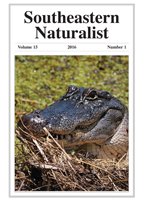Gambusia holbrooki (Eastern Mosquitofish) are often characterized as opportunistic surface feeders. We examined seasonal shifts in prey use, feeding specialization, and prey electivity to determine whether a feeding bias existed toward small planktonic prey. We sampled invertebrates (from the water column and from near plant surfaces) and Eastern Mosquitofish over 4 seasons in a wetland (Cobb County, GA). Gut analysis indicated seasonal shifts from large to small prey, particularly toward cladocerans, even when larger prey remained abundant. Small planktonic prey were consumed by all sizes of Eastern Mosquitofish. Electivities for cladocerans tended to be positive, whereas electivities for other prey, and especially copepods, were negative. Prey that would be expected to aggregate at the air—water interface were consumed in much greater proportions than those sampled elsewhere in the environment, suggesting that Eastern Mosquitofish are able to consume cladocerans caught in the surface tension.
How to translate text using browser tools
1 March 2016
Seasonal Specialization and Selectivity of the Eastern Mosquitofish, Gambusia holbrooki, Toward Planktonic Prey
Joseph M. Dirnberger,
Julia Love
ACCESS THE FULL ARTICLE

Southeastern Naturalist
Vol. 15 • No. 1
March 2016
Vol. 15 • No. 1
March 2016




